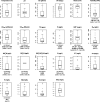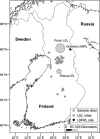Surface Water Intrusion, Land Use Impacts, and Bacterial Community Composition in Shallow Groundwater Wells Supplying Potable Water in Sparsely Populated Areas of a Boreal Region
- PMID: 34730413
- PMCID: PMC8567237
- DOI: 10.1128/Spectrum.00179-21
Surface Water Intrusion, Land Use Impacts, and Bacterial Community Composition in Shallow Groundwater Wells Supplying Potable Water in Sparsely Populated Areas of a Boreal Region
Abstract
Rural communities often rely on groundwater for potable water supply. In this study, untreated groundwater samples from 28 shallow groundwater wells in Finland (<10 m deep and mostly supplying untreated groundwater to <200 users in rural areas) were assessed for physicochemical water quality, stable water isotopes, microbial water quality indicators, host-specific microbial source tracking (MST) markers, and bacterial community composition, activity, and diversity (using amplicon sequencing of the 16S rRNA gene and 16S rRNA). Indications of surface water intrusion were identified in five wells, and these indications were found to be negatively correlated, overall, with bacterial alpha diversity (based on amplicon sequencing of the 16S rRNA gene). High levels of turbidity, heterotrophs, and iron compromised water quality in two wells, with values up to 2.98 nephelometric turbidity units (NTU), 16,000 CFU/ml, and 2,300 μg/liter, respectively. Coliform bacteria and general fecal indicator Bacteroidales bacteria (GenBac3) were detected in 14 and 10 wells, respectively (albeit mostly at low levels), and correlations were identified between microbial, physicochemical, and environmental parameters, which may indicate impacts from nearby land use (e.g., agriculture, surface water, road salt used for deicing). Our results show that although water quality was generally adequate in most of the studied wells, the continued safe use of these wells should not be taken for granted. IMPORTANCE Standard physicochemical water quality analyses and microbial indicator analyses leave much of the (largely uncultured) complexity of groundwater microbial communities unexplored. This study combined these standard methods with additional analyses of stable water isotopes, bacterial community data, and environmental data about the surrounding areas to investigate the associations between physicochemical and microbial properties of 28 shallow groundwater wells in Finland. We detected impaired groundwater quality in some wells, identified potential land use impacts, and revealed indications of surface water intrusion which were negatively correlated with bacterial alpha diversity. The potential influence of surface water intrusion on groundwater wells and their bacterial communities is of particular interest and warrants further investigation because surface water intrusion has previously been linked to groundwater contamination, which is the primary cause of waterborne outbreaks in the Nordic region and one of the major causes in the United States and Canada.
Keywords: 16S rRNA; bacteria; drinking water; groundwater; groundwater bacteria; isotopes; microbial diversity; potable water; rural; water quality; water supply; wells.
Figures







References
-
- Foster S, Chilton J, Moench M, Cardy F, Schiffler M. 2008. Groundwater in rural development: facing the challenges of supply and resource sustainability. The World Bank, Washington, DC.
-
- Morris BL, Lawrence ARL, Chilton PJC, Adams B, Calow RC, Klinck BA. 2003. Groundwater and its susceptibility to degradation: a global assessment of the problem and options for management. division of early warning and assessment, United Nations Environment Program, Nairobi, Kenya.
-
- UN World Water Assessment Program (WWAP). 2003. The United Nations world water development report: water for people, water for life (executive summary). UNESCO Publishing, Paris, France.
-
- Giordano M. 2009. Global groundwater? Issues and solutions. Annu Rev Environ Resour 34:153–178. doi:10.1146/annurev.environ.030308.100251. - DOI
Publication types
MeSH terms
Substances
LinkOut - more resources
Full Text Sources
Medical

